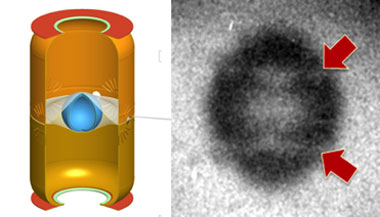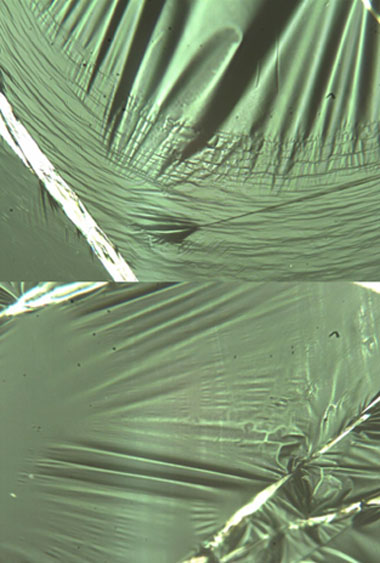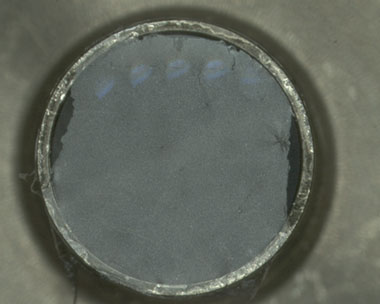Michael Stadermann (14-ERD-025)
Abstract
Ultrathin, tough, and defect-free polymer films are of interest to a variety of applications such as coating, packaging, separation membranes for desalination or carbon sequestration, masking layers for lithography, and sensor films. These ultrathin polymer films, whose thickness is comparable to the size of the molecules, also serve an important function in Inertial Confinement Fusion targets, where they support the fuel target in the center of the hohlraum target capsule. We advanced thin-film synthesis and mechanical properties by producing, characterizing, and modeling freestanding films of atomic-scale thickness with sufficient strength to support macroscale objects. We studied the mechanical properties of ultrathin freestanding polymer films using both experiment and modeling with a special emphasis on yield and failure strain, two properties that remain virtually unstudied. We also examined the mechanical properties of ultrathin films as a function of their thickness and chemical composition, with the ultimate goal of understanding how the mechanical properties are influenced by chemical composition. During the course of this project, we developed new methods for characterization of these films and modeling of their behavior, and measured yield behavior and ultimate strain of these films for the first time. A change in yield behavior at low film thickness was identified, and chemical changes to the polymer film were used successfully to alter mechanical properties. Further, composites were studied that integrated nanometer-scale materials such as graphene and carbon nanotubes with the films to dramatically increase modulus and yield stress. In addition, a range of new tools and methods for thin-film synthesis and characterization were developed, some of which has already been applied to the development of new target designs for Inertial Confinement Fusion. Our film synthesis technology garnered an R&D100 Award in 2016, and several of the new materials developed under this project will be studied for other applications in future projects.
Background and Research Objectives
Ultrathin tough polymer films (Figure 1) are of great scientific interest because they represent a means to confining polymer chains in two dimensions. Many properties normally assumed to be intrinsic—such as glass transition temperature, modulus, and yield strain—change at low film thickness. These changes originate in the confinement of the polymer chains: as the film thickness shrinks to the scale of the polymer molecules, the diffusion volume of the polymer is restricted, and properties such as the degree of entanglement change. Study of these changes is hoped to improve insight into glassy behavior, one of the major unsolved problems of condensed matter physics. Because of their inherent fragility, ultrathin films are typically studied on substrates. This reduces the number of parameters that can be studied and distorts the results because of interaction of the film with the substrate. Free-standing films of thickness below 10 nm are virtually unstudied.
Figure 1. A 15-nm film of formvar polymer stretched across a 5-mm hoop supports a steel ball that weighs 30 mg, more than 80,000 times the mass of the polymer film.
At Lawrence Livermore, these films are used to mechanically support fuel capsules inside hohlraum laser targets for Inertial Confinement Fusion (Figure 2), where their low mass and high strength is of interest. While films with thicknesses down to 30 nm were found to be reliable, thinner films reduced yield of targets to 70% or less, and finding a way to reliably field targets with thin films was desired.
Figure 2. An ignition style target (left). The fuel capsule (blue) is supported by very thin polymer films. Emission image from a recent implosion experiment (right). An ideal implosion would be round and featureless. The perturbations indicated by the red arrows are where the 110-nm support films detach from the capsule.
A primary research objective was to find a method to measure the mechanical properties (modulus, yield stress, and ultimate strain) of ultrathin polyvinyl formvar films, and to measure them as a function of thickness. These data would be used to compare to ab initio and molecular dynamics models of polymers to determine what drives the mechanical properties on the molecular level. The chemical structure could then be altered, both by changing chain properties as well as side groups, to verify the simulation. Our goal was to determine why the thinner films fail, and which mechanical properties must be improved to make the thinner films suitable for use in Inertial Confinement Fusion targets, so that chemical modifications could be applied that would result in a stronger, more reliable film. We also proposed to create composite materials using graphene as an alternative capsule-support material. In addition, we proposed the development of ultrastrong carbon nanometer-scale tube composite films. Our work leveraged previous work employing thicker nanotube mats infiltrated with polymer and cross-linked with radiation to increase mechanical strength.
We quickly determined that the extraction of mechanical properties was both more difficult and showed greater variability than originally expected. A finite-element analysis of mechanical indentation was used to match experimental data with simulated data to determine mechanical properties. While the measurements are straightforward and repeatable, the initial finite-element methodology took over a year to develop and remained a chokepoint throughout the project's duration. Correspondingly, the ab initio and molecular dynamics modeling was dropped, because the comparison data was not available in time. Nevertheless, using the finite-element model and ball indentation data, it was possible to determine the impact of film thickness on modulus, yield stress, failure strain, pre-strain, index, and glass transition temperature for film thicknesses ranging from 150 nm all the way down to 6 nm.
Adjustment of film properties with chemical means was pursued with good success, and an additional study of the dynamic properties was added. This study provided insight of the ultimate failure mechanism for the films in Inertial Confinement Fusion targets, but a mitigation could not be found. The development of polymer graphene composites was a natural extension to the chemical modification work, and produced great results in the final year.
During the project, it became obvious that making the films thinner would not remove the instabilities caused by them during implosions at Livermore's National Ignition Facility, and alternate support designs were investigated outside of this project. However, several designs still involved films, and the methods and models we developed greatly accelerated the progress. Finally, our work on nanotube polymer composites was concluded with good success after two years.
Scientific Approach and Accomplishments
The most difficult part of producing an ultrathin, free-standing film is the separation of the film from the surface it was prepared on. All ultrathin films were produced using polyelectrolyte enhanced lift off, which was refined during this project. With this method, a polymer solution is spun onto a silicon wafer prepared with a monolayer of polyelectrolyte, and then the substrate is dipped into water once the solution has dried. Even very thin films can be released from substrates with this method.
The primary characterization method consisted of ball indentation, which uses a stepper motor to push a sphere into the taut film that is mounted on a holder, and the resulting force is measured with a precision balance. Despite its low cost, this method is capable of measuring even the thinnest films tested. Thickness was characterized with ellipsometry, which was also used to measure the glass transition temperature.
Initially, an analytic equation was used to extract mechanical properties from the indentation data. This equation was insufficient to reveal minor changes in the properties, but sufficient to reveal that there was variability between batches of films. In the first year, effort was put into controlling production and test conditions. While test conditions were fairly easy to control, it was not possible to control the production conditions with the available setup, and we designed a sealed spin coater with fully controllable temperature, pressure, and humidity. Another method we attempted to remove variability was annealing of the films near the glass transition temperature. This proved somewhat successful, but also clearly changed the properties of the films: annealed films were stiffer and showed reduced viscoelasticity. It was also observed that the yield mechanism of these films changed. While un-annealed films yielded by shear thinning, the annealed films would yield by crazing—the formation of minuscule cracks that are bridged by highly oriented polymer chains (Figure 3). At room temperature, films that yield by crazing would relax at a slower rate, resulting in an overall more stable film. However, at cryogenic temperatures, these films would fail at a substantially higher rate. We speculated that this weakness comes from the fact that at very low temperatures, the polymer behaves like a glass, and a film that has yielded without crazing is more stable than one that crazed, because the microcracks serve as stress risers. The propensity to craze is not only increased by annealing, but also by reducing film thickness, and it is currently believed that it is this change in yield behavior that limits the use of 15-nm-thick films in Inertial Confinement Fusion targets.
Figure 3. Two films after plastic deformation. A film that has yielded by crazing is shown on the top. The dark lines are cracks in the material that are bridged by many tiny filaments of aligned polymer strands. A film that has yielded by shear-thinning is shown at the bottom. The material has become thinner, but shows no spatial anisotropy.
Completion of the finite-element model revealed a lower variance in mechanical properties than initially assumed. The model was built in ANSYS simulation software and uses both full three-dimensional simulations as well as axially symmetrical one-dimensional simulations. The film is partitioned into elements of negligible thickness, and the material properties of the elements are given by a stress–strain curve. The model is used to iteratively produce indentation curves by varying the parameters of interest to fit modulus and pre-strain, or even more complex behavior. The model demonstrated that the analytical equation results strongly depend on the pre-strain of the film, which varies with synthesis conditions. The model was used to analyze a large data set of indentation curves for film thicknesses ranging from 6 to 150 nm, and for two different polymer molecular weights. The analyzed data show a clear change in all mechanical properties for thicknesses starting at 30 nm, irrespective of the molecular weight of the polymer from which the film was made. The modulus and ultimate strain decrease, while yield stress and pre-strain increase. This result runs counter to results reported in the literature, in which onset of property change is always dependent on the molecular weight of the polymer. It is possible that the material used in this project is too poly-disperse to relate the onset thickness to the molecular weight.
We modified the polymer by cross-linking the hydroxyl functional groups in the polymer to each other using bisphenol A and similar cross-linkers. The cross-linking showed the expected results of increasing the yield strength, but the density of functional groups was too high to achieve substantial amount of cross-linking. A different polymer with a higher density of cross-linkable groups will be required to substantially modify the mechanical properties in this fashion. We created graphene composites by removing wafer-grown graphene from the substrate and floating it onto a pre-made polymer film. This radical departure from the conventional technique, which uses slurries of graphene in polymer solutions to cast films, resulted in films that have a higher graphitic content while attaining a lower thickness. The composite material is 10 times stiffer and has more than 2.5-times higher yield strength than either individual component (Figure 4). Overall, our project has produced a record of invention, as well as an R&D 100 award for the polyelectrolyte enhanced liftoff process.
Figure 4. A graphene and polymer composite film was assembled layer by layer. The graphene was etched off of its support and then floated onto a free-standing polymer film. This composite is 10 times stiffer than the individual components and has been produced at thicknesses as low as 12 nm
Impact on Mission
Improved understanding of thin-film strength and advanced composite materials supports the Laboratory's advanced materials and manufacturing core competency, and will be useful to guide material selection for target capsule support, which is relevant to ignition-class laser fusion experiments in support of the stockpile stewardship science mission and for inertial fusion science and technology applications. Our enhanced understanding of polymer behavior has identified fundamental limitations for the thickness of films that is usable in these targets, and provided the mechanism that is the limiting factor. The modeling further provides direction in which film properties need to be developed to overcome these limitations. In addition, the improved understanding gained from our research has been valuable in developing new capsule support methods. The four-part hohlraum, a new design that uses much stiffer carbon and polyimide composite films at low strain, could be developed and deployed quickly thanks to the methods and knowledge derived from this project. Our work on carbon nanotube composites has been transferred to nanotube yarns, a new material also being developed for capsule support. Graphene composite ultrathin films show promise for separation applications, such as water desalination, and tests for this application may be pursued with the Lawrence Livermore's Innovation Development Funding designed to support the enhancement of technology transfer activities at the Laboratory.
Conclusion
Our understanding of ultrathin films, their synthesis, and their characterization, was greatly enhanced during this project, and the results have already aided other projects at Lawrence Livermore. Because of the slow processing of data with the finite-element model, a sizeable amount of data on yield mechanism and the composite material still remains unpublished. These data will be published within the next year, as the model results become available. A number of new tools and methods were developed during this project. The ball indenter coupled with-finite element modeling is a very powerful tool for measuring mechanical properties of thin films, and it is indispensable for further development of thin films as well as quality assurance of production films. Our split-diagnostic band test assemblies are now routinely used as simplified target setups to determine mechanical and cryogenic stability of new target assemblies. Two postdoctoral researchers contributed to this project, with one being converted to a staff scientist. Finally, our polyelectrolyte enhanced lift-off process has started to gather interest from industry, and there are ongoing conversations with several parties for its use in thin-film fabrication. The graphene composite is likewise of commercial interest, and will hopefully continue development with support from the Laboratory's Innovation Development Funding program.
Publications and Presentations
- Stadermann, M., Determining thickness and refractive index from free-standing ultra-thin polymer films with spectroscopic ellipsometry. (2016). LLNL-TR-697144.
- Stadermann, M., “Fabrication of large-area free-standing ultrathin polymer films.” JoVE e52832 (2015). LLNL-JRNL-662583. http://dx.doi.org/10.3791/52832









